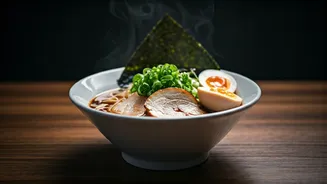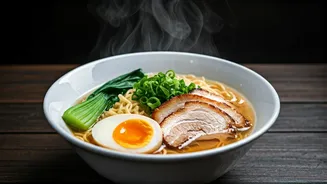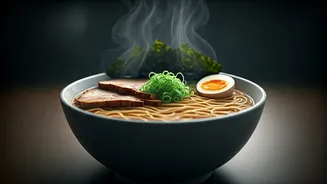Ramen's Humble Beginnings
Ramen, a dish that has captured the hearts of food enthusiasts across the globe, boasts a history as rich and layered as its complex flavors. While its exact
origins are debated, ramen's roots are often traced back to China, where wheat noodles in broth were a common staple. These Chinese-style noodles eventually made their way to Japan, evolving and adapting to local tastes and ingredients. During the Meiji period (1868-1912), the dish began to take shape as we know it today. Initially, it was a simple, affordable meal favored by laborers. Over time, regional variations emerged, each with its unique broth, toppings, and noodle styles. Today, ramen is an art form, with chefs meticulously crafting each element to create a symphony of flavors and textures, making it one of Japan's most beloved and iconic dishes. The journey of ramen mirrors the evolving culinary landscape, a testament to the power of food to bring people together.
Broth: The Soul of Ramen
The heart of any exceptional ramen bowl lies in its broth, a labor of love that can take hours, even days, to perfect. The foundation of the broth dictates the overall flavor profile of the ramen, and the most common broths are tonkotsu (pork bone), shoyu (soy sauce), miso (fermented soybean), and shio (salt). Tonkotsu broth, known for its rich and creamy texture, is made by simmering pork bones for extended periods until the collagen breaks down, infusing the broth with a milky hue and a deep, savory taste. Shoyu broth, on the other hand, is a lighter, clear broth seasoned with soy sauce, offering a balance of umami and saltiness. Miso broth, with its earthy and fermented flavor, is derived from miso paste, often combined with other ingredients like vegetables and seafood. Shio broth is the simplest, relying on salt to highlight the natural flavors of the other ingredients. Each broth style presents a unique experience, allowing for a wide range of flavor combinations and culinary explorations.
Noodles: Perfecting the Texture
The noodles are as crucial as the broth, providing the satisfying chew and texture that define a great bowl of ramen. The type of noodle used can significantly impact the overall experience, with a variety of shapes, thicknesses, and ingredients. Ramen noodles are generally made from wheat flour, salt, water, and kansui, an alkaline mineral water that gives the noodles their characteristic yellow color and chewy texture. The noodles come in different forms: thin, thick, straight, and curly, each complementing different broths and toppings. Thinner noodles often pair well with lighter broths, while thicker noodles can stand up to richer, heavier broths. The cooking process is critical, with precise timing to achieve the ideal texture. Overcooked noodles become mushy, while undercooked noodles lack the desired bite. The perfect ramen experience is all about balancing the texture of the noodles with the richness of the broth and the other elements in the bowl.
Toppings: Elevating the Bowl
Toppings are the final flourish, transforming a bowl of ramen into a culinary masterpiece. They add flavor, texture, and visual appeal. Classic toppings include chashu pork (braised pork belly), marinated soft-boiled eggs, bamboo shoots (menma), green onions (negi), and nori seaweed. Chashu pork is slow-cooked, resulting in tender, melt-in-your-mouth slices that add richness and depth to the broth. Marinated eggs with a perfectly runny yolk contribute a creamy element. Bamboo shoots provide a subtle crunch and a unique fermented flavor, while fresh green onions add a refreshing bite and visual contrast. Nori seaweed contributes an umami taste and a textural contrast. There are countless other toppings, such as mushrooms, corn, bean sprouts, and various types of seafood, allowing for endless customization and experimentation. The art of ramen lies in the thoughtful combination of these toppings to create a well-balanced and satisfying bowl.
Crafting Your Ramen Bowl
Creating a delicious ramen bowl is a journey, not a destination, requiring patience and attention to detail. First, prepare your broth, following a chosen recipe, simmering it until the flavors meld. Next, cook your noodles to the perfect texture. Meanwhile, prepare your toppings: chashu pork, marinated eggs, and any vegetables or additions you enjoy. Once all components are ready, assemble the bowl. Place the cooked noodles in the bowl, pour the hot broth over them, arrange the toppings artfully, and add a final sprinkle of green onions. Experiment with the proportions and ingredients until you find the perfect balance that satisfies your palate. Start simple, trying different broth bases, noodle types, and toppings to discover your signature ramen. Ramen making is a culinary adventure, and each attempt brings you closer to perfecting the art.














